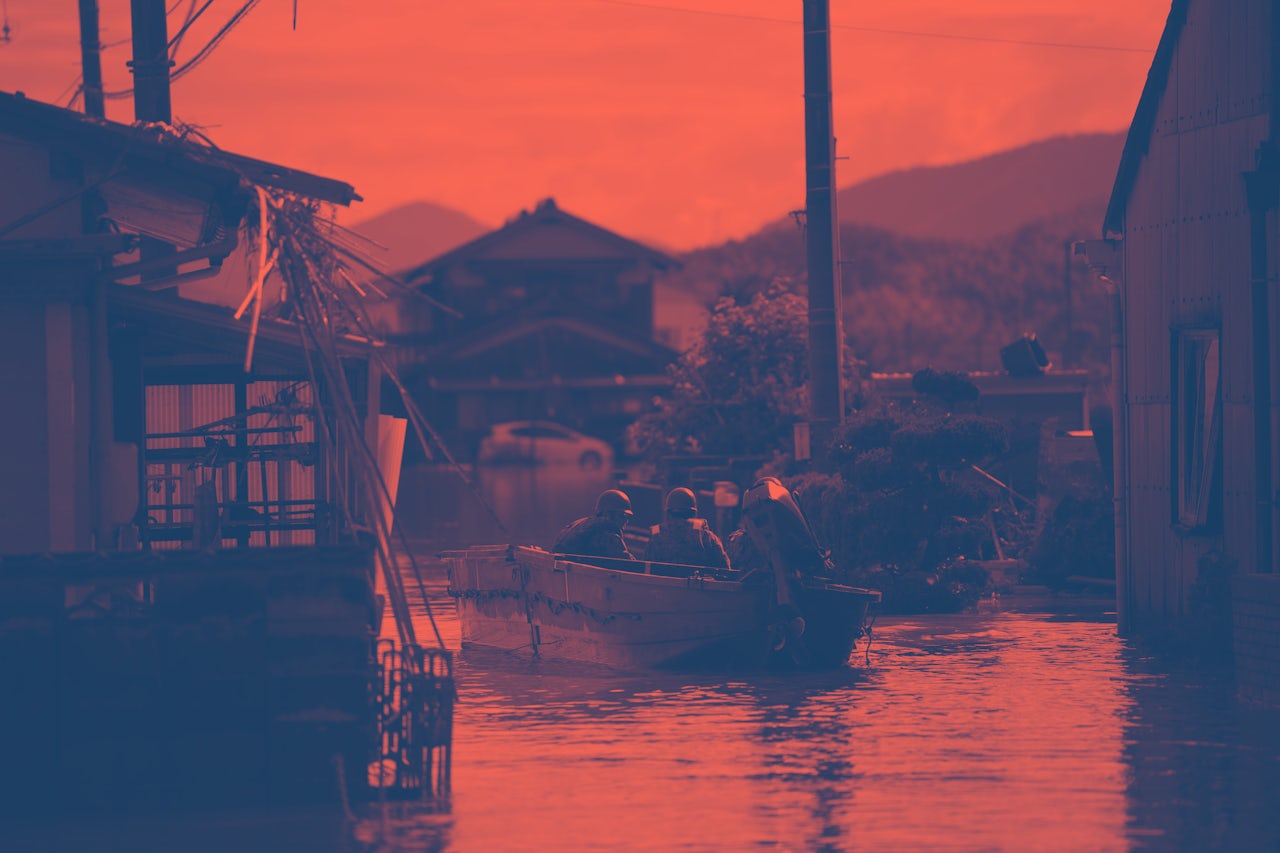In Japan, what started as a downpour on June 28 refused to relent, dug in its heels, and kept dumping rain on southern Japan for more than two weeks, and at least 176 people lost their lives. A blanket of water 847 million cubic feet in scale flooded the region, destroying almost 2,000 homes. The worst-hit regions were struck with about 70 inches of rain—almost six feet. Then, on July 9, just as the rain stopped, a barrage of simultaneous landslides devastated thousands of square miles in Western Japan, causing over 100 of the 176 deaths.
The flooding in Japan is a tragic example of what happens when climate change raises the threat of dangerous but (at least at the time of onset) sub-emergency weather, like torrential rain, in regions that aren’t used to experiencing comparable events like typhoons or hurricanes. The country had no reason to expect that the event would be so extreme, and as a result, it didn’t have the emergency response mechanisms in place to properly deal with the issue. As climate change makes weather more unpredictable, particularly when weather forecasting relies on relatively calm historical information, the potential for unexpected consequences is much higher.
According to a report published last year in the the Bulletin of the American Meteorological Society, climate change can take bad but otherwise normal weather events and push them past the tipping point, making them an extreme weather event. While studies will be required to link Japan’s extreme rain to climate change without a shadow of doubt, we already know that climate change makes extreme rain events both more extreme and more likely.
While the Japanese prime minister's office and the Ministry of Defense kept their finger on the pulse of the storm for several days, they didn’t escalate the response to that of an emergency disaster until July 8—the day before the landslides.
Extreme rain events is a common phenomena in many Pacific-adjacent areas of land, but not Japan. It’s a temperate region prone to earthquakes and tsunamis, but extreme rainfall is not typically a weather threat that’s persistent enough to take seriously. An unnamed Japanese weather official told the BBC, “We’ve never experienced this kind of rain before.” The only comparable event was in 1983, when torrential rains flooded southern Japan and killed 112 people. 35 years is far from being frequent enough to stay on the radar.
When greenhouse gases retain heat in the atmosphere, it can go one of three places: it can stay in the air, be absorbed by vegetation, or be taken up by the ocean. Consistently hot air superpowers convection—or the process where hot air is uplifted into the atmosphere, allowing clouds to form. That’s why climate change doesn’t just make rain more likely, it also makes ultra-strong, heat-powered rain events more likely—even in a region that isn’t consistently prone to extreme rain, like Japan.
Hiroshima, which was one of the worst-hit regions from this weather event, has fallen victim to landslides in the past. In 2014, a particularly lethal landslide took 77 lives. However, the damage of this disaster was largely local. An unnamed weather official based in Hiroshima told Mainichi news, "We've had no experience of disasters occurring like this over a wide area at the same time." Put simply: the scale of the event is unprecedented. In 2014, the event was local to just Hiroshima. This series of landslides affected 13 separate regions of Japan, all at once. Back in 2016, scientists from the University of Colorado-Boulder postulated that climate change widened the path of extreme Northeast winter storm Jonas, allowing it to dump more snow on a wider area of land than it should have. Similarly, Japan wasn’t just hit by extreme rainfall in one area: it struck the entire bottom half of the country.
Japan’s Meteorological Agency has a budget of $57.8 billion, so it’s not that it’s underfunded and drawing up poor predictions. But meteorology works by considering weather in the past. When there’s little to no precedent for an event, there’s not as much of a reason to expect it in the present. Disaster preparedness works the same way: governments figure out how to respond to an issue based off of which responses worked and didn’t work in the past. So what do they do when they’re faced with an event of quite literally unprecedented scale?
According to Japanese news outlet Mainichi news, the Japanese Meteorological Agency didn’t realize that the rain event would add up to record-high numbers until July 5—about a week into the weather event. As a result, the Japanese Cabinet Office didn’t mandate the evacuation of 150,000 people in already-flooded regions until later that day. For vulnerable populations like the elderly, sick, or economically disadvantaged, it was simply too late to evacuate. The number of recommended evacuations has since been upped to 2 million.
Climate change is dangerous largely because it has the capacity to unearth the corruption, inefficiencies, and inadequacies in governments. When there’s a climate change-driven disaster, all of these vulnerabilities come to light. However, it’s just as scary to consider that high death tolls aren’t always driven by corruption. What was true in the past simply isn’t true for the present, and it won’t be true for the future. Even for competent scientists and leaders, that’s an incredibly difficult challenge to face.
